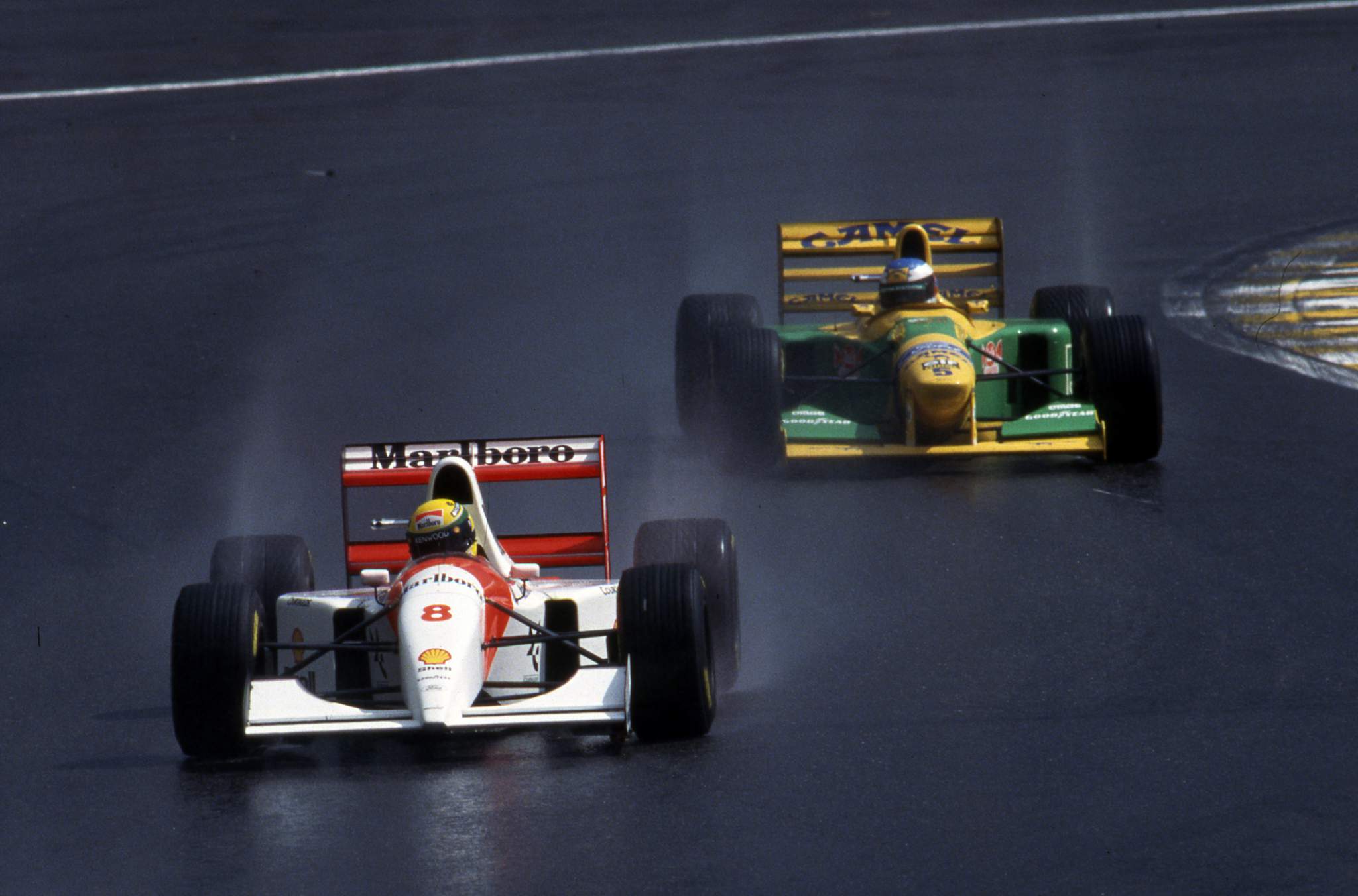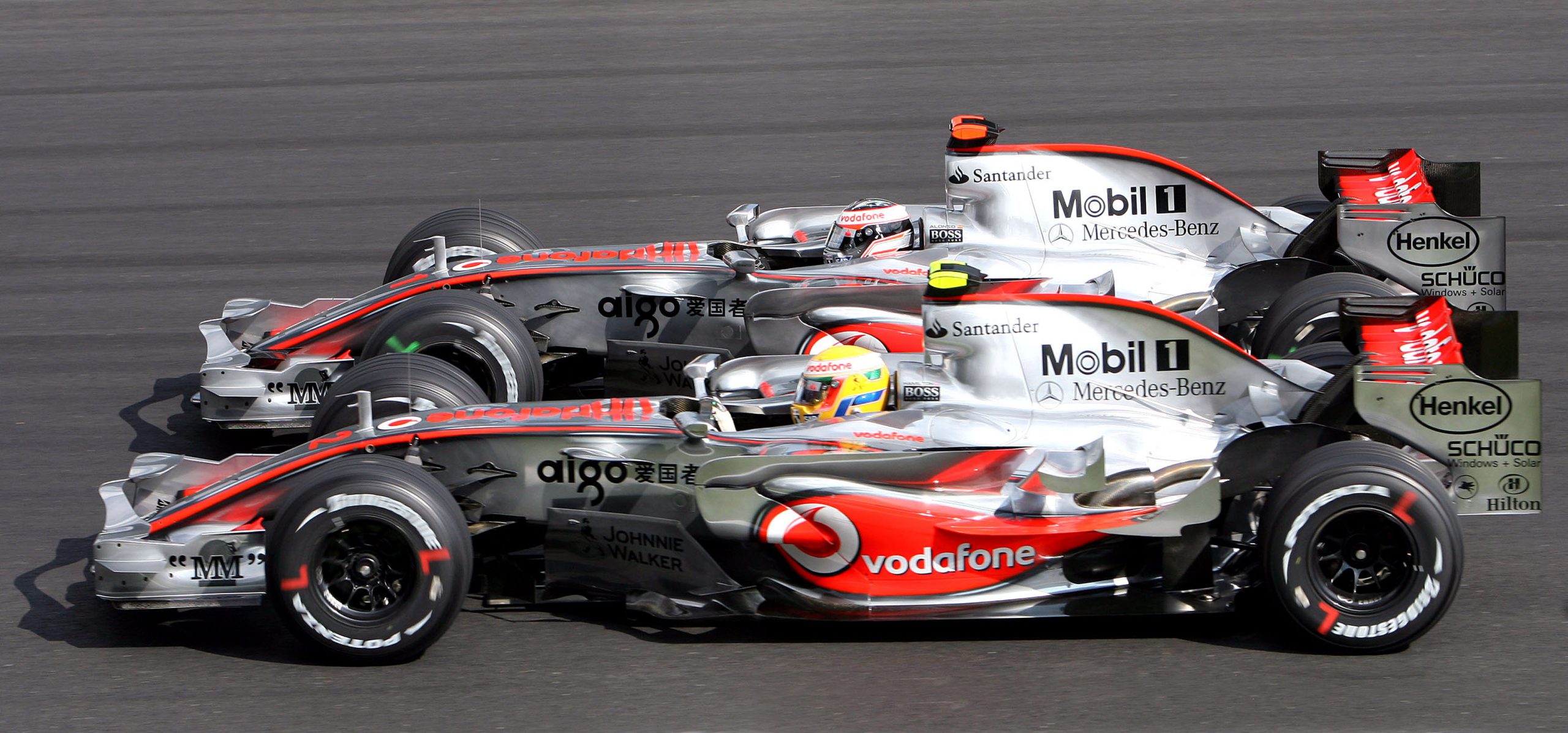Up Next

Lewis Hamilton is at the peak of his Formula 1 powers – winner of more grands prix than anyone else, equal with Michael Schumacher for championships and on a run of six titles in seven seasons.
And yet he goes into 2021 with his Mercedes team perhaps on the backfoot, uncertainty over his future in F1 beyond this season, and with Max Verstappen – 13 years younger than Hamilton – eager to stake his claim as the next great on the grid.
Are we about to see the Hamilton/Verstappen era transition? It would be far from the first time that one F1 legend claimed the baton from another.
Last year Mark Hughes took a look at how that changeover unfolded in the three most recent cases.
Ayrton Senna/Michael Schumacher
Schumacher was dicing with Senna as early as his second grand prix, Monza 1991, just a couple of weeks after creating such a sensation on his debut at Spa. It wasn’t long before the needle began.
At the beginning of ’92 Senna was 32 years old and about to embark on his eighth season in F1, already a living legend.
Schumacher was 23 and clearly extraordinary. Senna’s target had been Alain Prost, so Schumacher knew who he had to measure up to – but it was actually a genuine misunderstanding that triggered the first proper niggle at Senna’s home race of Brazil, then early in the season.
A wiring problem was causing the engine in Senna’s McLaren to intermittently cut in the early stages of the race and he soon had a big queue of cars lined up behind him, headed by the Benetton of Schumacher who believed that Senna was deliberately lifting off and brake-testing him at strategic places to stop him passing.
Senna apologised to Schumacher for apparently inadvertently almost taking him out as he pulled over to retire. It may have been accidental…
“It was not necessary behaviour for a three-time world champion,” Schumacher complained publicly afterwards, unaware of Senna’s engine cut-outs, and with Senna not around to give his side of the story, having stormed off home when his car finally gave out.
Senna made specific mention of Schumacher’s Brazil outburst at their next altercation – after a collision between them on the first lap of the French Grand Prix.
Schumacher had somewhat naively tried sitting it out down the inside of the hairpin without ever being fully alongside. Senna cut across, they collided – and Senna was out.
The race was subsequently stopped and Senna, now in civvies, made his many finger-waving points to Schumacher very publicly on the grid and later said to friends, “Great, I got him just before he got in the car”.
Their Magny-Cours incident was almost carbon-copy repeated at Kyalami in the first race of the ’93 season, only this time Schumacher was fully alongside and Senna very deliberately chose to have the accident rather than yield. It put Schumacher out on the spot while Senna continued.
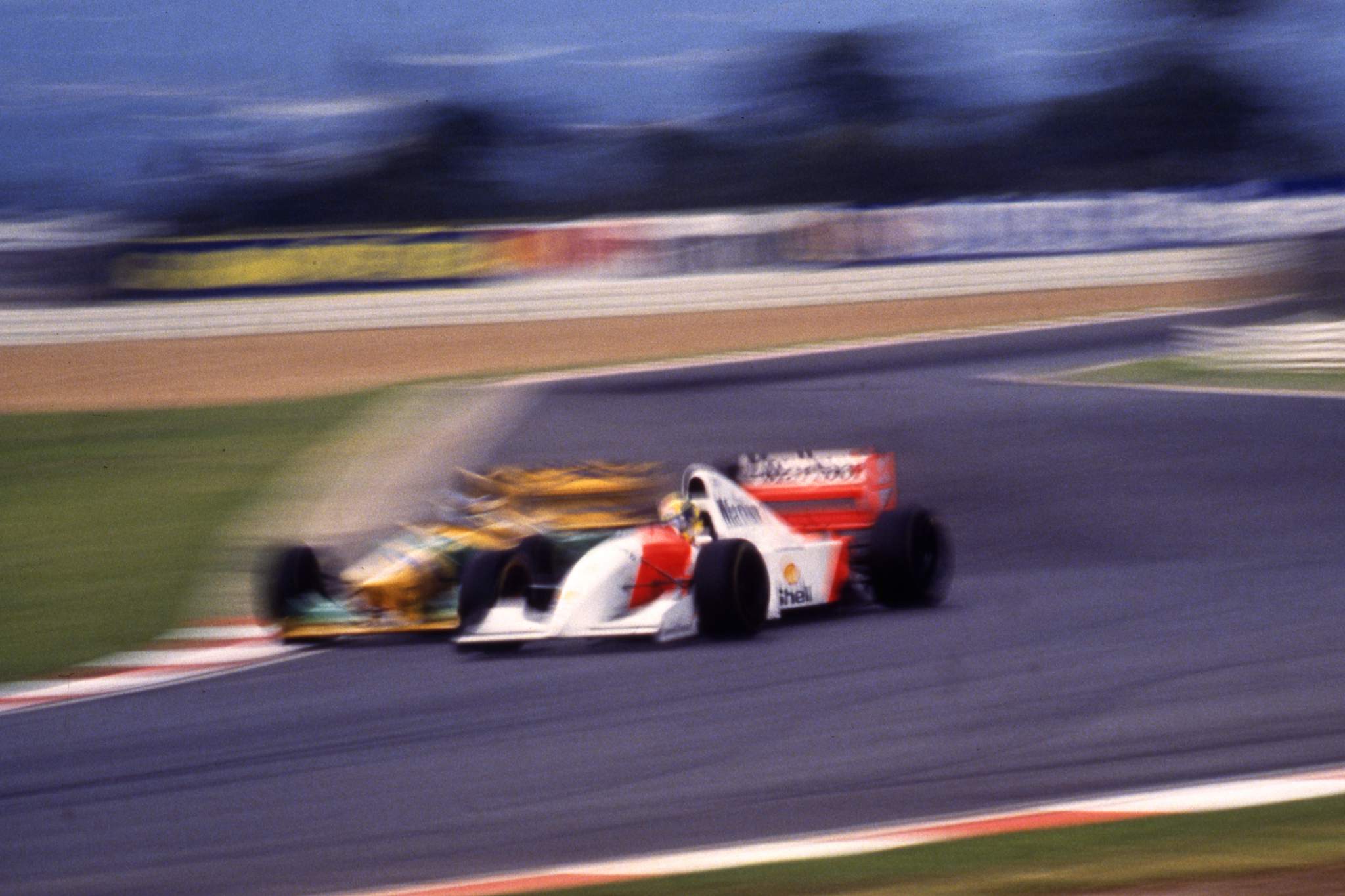
Later that year in Monaco, Schumacher – having outqualified Senna by 0.4s – was dominating the race, 15s ahead by lap 27 of 78, when his hydraulics gave out, handing the win to Senna.
At this track of all places, where Senna prided himself on being able to make the difference, inheriting a win only after falling ever-further behind the boy wonder would not have sat easily.
In Canada for the next race Senna apologised to Schumacher for apparently inadvertently almost taking him out as he pulled over to the side to retire. It may have been accidental…
In France ’93 Schumacher used a two-stop strategy to overtake Senna’s one-stopping McLaren in the late stages of the race to snatch a podium from his grasp. At Silverstone Schumacher set a stunning qualifying lap in his team-mate Riccardo Patrese’s Benetton, 1.5s faster than Senna’s identically-powered McLaren. Senna got away quicker at the start but Schumacher passed him with ease quite early in the race.
Schumacher prevailed for second (to Damon Hill’s Williams) at Spa only after Senna veered across on him as he exited from his pitstop, putting the Benetton on the grass on the exit of La Source. Schumacher kept his foot in and forced his way ahead down the hill.
It was only in the last few races of the year that Senna regained the upper hand over Schumacher he’d enjoyed early in the season. But their duels promised a fantastic ’94 season that instead played out tragically with Senna’s death at Imola, crashing while driving flat-out as Schumacher pressured from behind.
Michael Schumacher/Fernando Alonso
By the early part of the first decade of the new millennium, with his great rival Mika Hakkinen retired, there were several pretenders to Schumacher’s status as top dog.
Was it going to be the wildcat Juan Pablo Montoya fresh from sensational form in CART Champ Car?
Or Kimi Raikkonen, starring as the fearless and gifted new kid? Or Fernando Alonso who had punched way above his Minardi’s weight in his rookie season prior to a year as third driver with Renault?
Promoted to a Renault race seat in 2003, 22-year-old Alonso would stake the most certain claim to being 34-year-old Schumacher’s most likely future threat.
At the Nurburgring, Schumacher was forced into a defensive drive on Bridgestones that were not as good on the day as the Michelins enjoyed by the competition.
After being nudged into a spin by Montoya, he was recovering and in the late stages was closing in on Alonso’s fourth place. Schumacher was catching the Renault through the long final turn, clearly trying to position himself to slipstream it down the pit straight.
But Alonso was wise to the move and mid-corner gave his pursuer a fairly rude ‘lift-off test’, losing Schumacher the momentum and ensuring he’d still be behind Alonso at the flag.
It was an indication that Schumacher’s reputation meant little to this aggressive little bull of a driver.
“It was OK,” Alonso shrugged. “Now I know what the rules are”
Two races later, at Silverstone, Alonso was slipstreaming Schumacher down the Hangar Straight in the early laps. As Alonso pulled to the right and began to get alongside, Schumacher coolly moved across on him, putting him on the grass at around 200mph.
It was an out-of-proportion payback for the Nurburgring, clearly intended to send a message. Alonso afterwards was unmoved. “It was OK,” he shrugged. “Now I know what the rules are.”
They rarely had direct wheel-to-wheel encounters for the next couple of seasons. The 2004 Ferrari was vastly quicker than Alonso’s Renault and the tables were turned for much of 2005 as Alonso marched to his first world championship while Ferrari struggled with its Bridgestones in the season when tyre changes were banned.
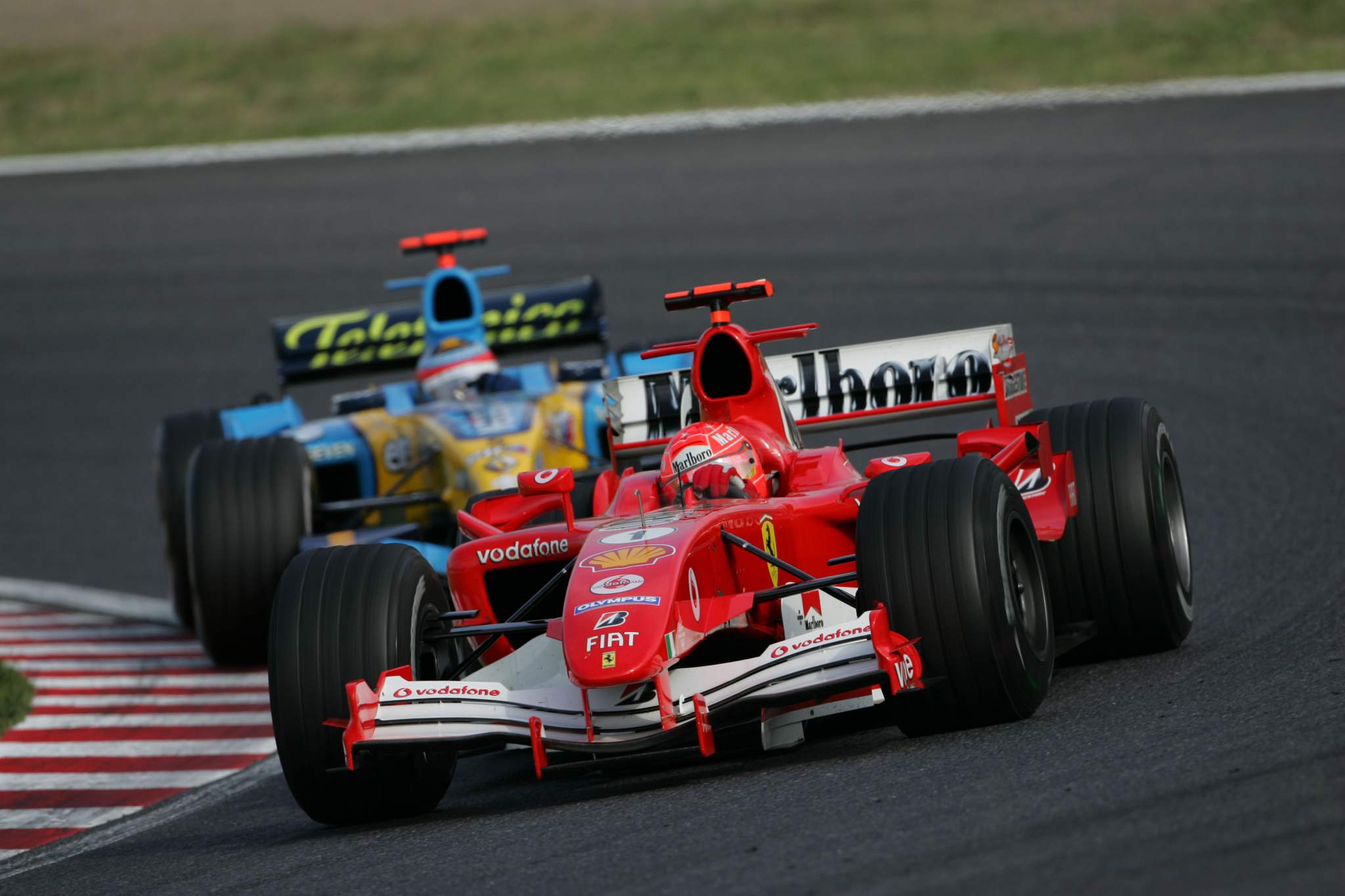
But then came the Japanese Grand Prix, where the Ferrari was, for once, in reasonably good shape.
The vagaries of the weather combined with single car qualifying meant that both Schumacher and Alonso were starting from near the back. They came through the midfield together from 14th and 16th on the grid, Schumacher ahead, but on the 20th lap Alonso made his move on the Ferrari.
With his world championship already sealed, Alonso had no need to be risking anything – but after slipstreaming Schumacher down the back straight, he had a run going on him as they approached the mighty 130R turn.
Michael defended the inside – and Alonso ran around his outside, wheels almost touching, to make the pass. Telemetry later confirmed that his mid-corner speed at the moment of the overtake was 208mph… It really did look like a baton being passed.
With more equally-matched car and tyres for 2006, Schumacher and Alonso battled out the title’s destiny in a fascinating season. Schumacher arguably still had more raw speed (his qualifying advantage over Felipe Massa [0.6s] was way bigger than Alonso’s over Giancarlo Fisichella [0.13s]), but Alonso took the title as Michael called time on his (first) career.
The competitive edge between them never did really dissolve. Upon Schumacher’s comeback with Mercedes in 2010, he’d still spend time in the Ferrari motorhome, catching up with old friends, and would take delight in telling new recruit Alonso where various things were located there.
Fernando Alonso/Lewis Hamilton
This one was unusual in that it unfolded within the same team. Furthermore, Alonso could count himself as unfortunate that the pretender to his recently-anointed status should come so soon.
With the guaranteed performance of the double world champion newly recruited to McLaren’s driving strength for 2007, team boss Ron Dennis felt comfortable taking on the rookie Hamilton alongside.
The breakdown of the Alonso-Dennis relationship would come to have disastrous consequences for them both
Alonso expressed some disquiet but was assured by Dennis having assigned him lead driver status.
But once the season began Hamilton’s incredible speed and composure as a rookie did not compute for Alonso, triggering some competitive paranoia.
Alonso had to use up a valuable second set of new tyres in qualifying for the first race just to ensure he had strategic priority over Hamilton – thereby potentially denying Alonso a useful advantage against the non-McLaren opposition. This did not sit well with him.
Alonso maintained the upper hand over Hamilton for the first two races, but the rookie beat him convincingly in Bahrain for round three.
This was too much: with the next race on Alonso’s home track of Barcelona he insisted on all of the test days there, and Hamilton was duly ‘un-invited’ to the test. Yet, once more the rookie beat the champion (albeit behind the winning Ferrari of Massa).
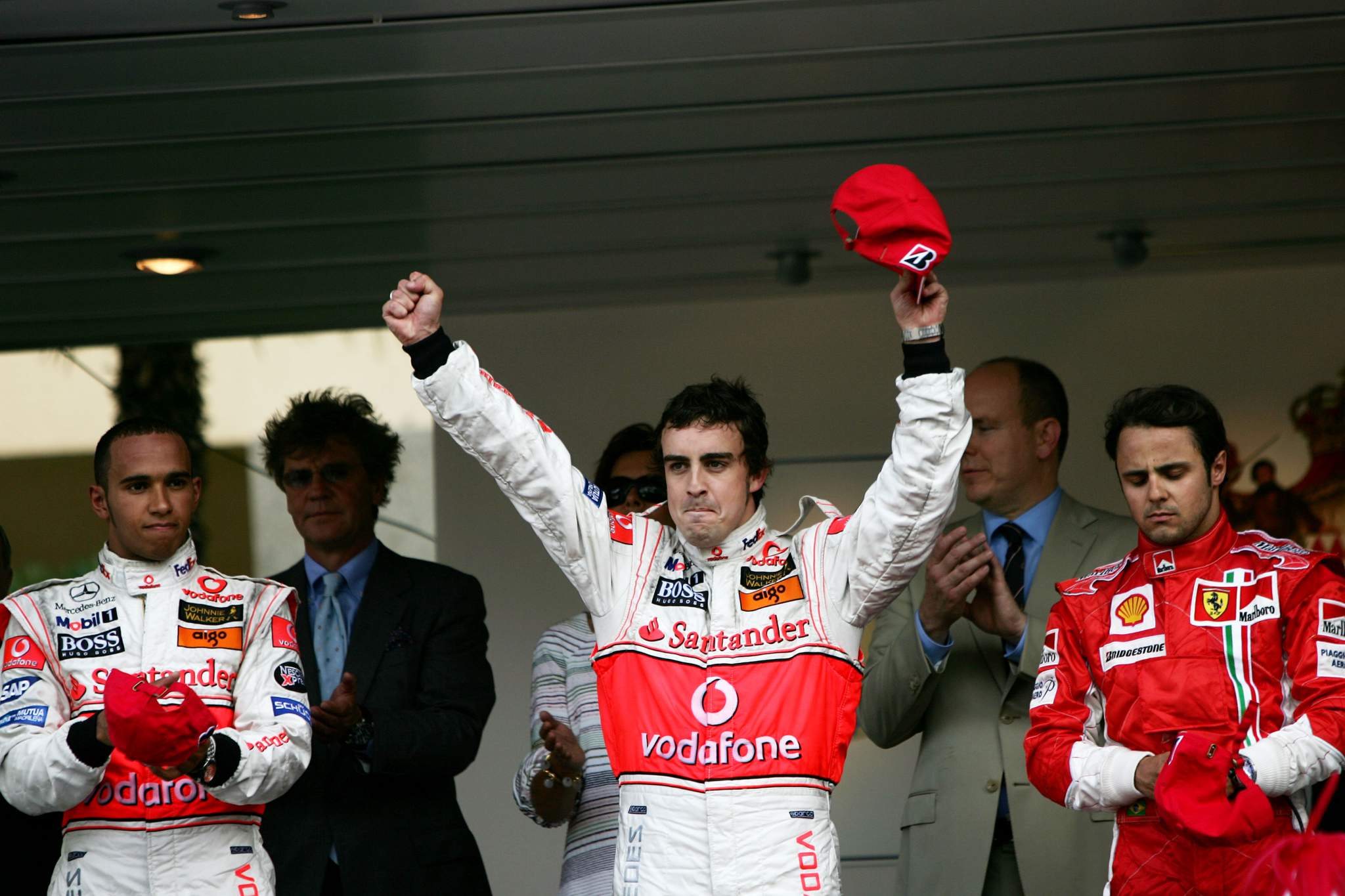
The McLarens locked out the Monaco front row, Alonso ahead after Hamilton was baulked on his final attempt.
Hamilton was fuelled considerably heavier and potentially held a strategy advantage over his team-mate – but wasn’t allowed to use it, as Dennis insisted the two cars retain position so as not to risk the team 1-2. Hamilton was furious at being denied what he felt was the chance to win.
Alonso felt slighted by Dennis’ explanation of how it had never been an actual race between them once Alonso had won the start. This was the beginning of the breakdown of the Alonso-Dennis relationship, something that would come to have disastrous consequences for them both – all triggered by the rookie’s incredible raw speed.
After Hamilton won the Canadian and American Grands Prix, he was leading the world championship and by now any idea of Alonso having team priority had been overtaken by events. Which angered Alonso.
When Hamilton pulled a trick on Alonso with his fuel burn laps in Hungary qualifying and Alonso responded by sitting stationary in the pits ahead of Hamilton, preventing him from making his final qualifying lap, it became all-out civil war.
Alonso’s veiled threats in the aftermath (relating to McLaren’s ongoing industrial espionage case with the FIA) effectively ensured his dismissal from the team at the end of the year. Which in hindsight seriously compromised the rest of his career and effectively made McLaren Hamilton’s team.
That was the foundation allowing Hamilton to always be in a competitive car (with the exception of 2009), the platform that would eventually put him in the dominant Mercedes while Alonso floundered in the right places at the wrong times.



